The Verde Valley Fly Fishers Association held a fly fishing workshop at the Camp Verde Community Library in conjunction with a visit to Page Springs Fish Hatchery on Thursday, July 20, that featured a presentation from founder and president John Doss on the basics of fly fishing and the equipment needed to get started.
Doss told the crowd that the kind of sport fishing he practices and encourages is catch and release. “Let it go, let it grow,” he urged his audience.
There are two kinds of fishing rods, the spin rod and the fly rod. A spin rod uses a lure that can be thrown a long way, while a fly rod uses a “fly” which, with the weight of the line, allows it to be thrown even farther. While the fly rod can be used to catch any fish, Doss said that fly fishers typically seek out trout.
The construction of the fly rod involves a leader, tippet and fly. The line tapers to make it harder for fish to see it. Other fly fishing accessories include a vest to hold tools such as clippers and extra flies, a net and waders. Doss showed off a fly-tying kit, saying that tying your own flies is one of the most fun parts of the sport.
He also addressed the safety equipment that can be used by the overcautious, such as long-sleeved shirts, hats, sunscreen, a wading belt to prevent water from spilling into the waders, whistles and wading staffs.
Fly fishing makes use of two styles of casting, the roll cast and the pickup-and laydown, the latter of which is apparently the backbone of fishing. Doss suggested that those practicing their casts avoid wrist action.
Tying knots is another key part of fly fishing, and Doss advised that prospective fishers practice at home to develop muscle memory. He recommended wetting the knots when tying to eliminate friction and help them to sink. Three essential knots for fly fishing include:
- Clinch knot — used to tie flies onto a line
- Surgeon’s knot — used to attach a tippet to a leader
- Perfection loop — used to connect a fly line to a leader
Doss then moved on to address the basics of fly fishing entomology. Small insects typically have a lifecycle with four stages: Nymph, emerger, adult or dry fly and spinner. Once the nymphs come out of the water and perform their mating cycle, they are considered emergers, while spinners are those that have already mated and float on the water.
Common insects fish eat include midges, mayflies, caddis flies and stoneflies. Tying flies is an attempt to replicate what the fish are naturally eating.
The essential fly ties to have when fishing in Arizona include the grasshopper pattern, ant, caddis, copper john, hare’s ear and the woolly bugger, which is one of the most successful flies.
“Part of the fun is figuring out what’s working and what’s not,” Doss said, observing that fly fishing involves a lot of experimenting to see what catches fish effectively. He joked that you can always ask the person fishing next to you who is catching a lot for advice.
Arizona is home to almost 30 sport fish species, including the Gila trout and the Apache trout, the latter of which is the state fish.
The Verde Valley Fly Fishers Association is a part of Fly Fishers Arizona, which is a certified chapter of Fly Fishers International. The association was founded to do community outreach, educate children and perform conservation work.
“It gets the kids outdoors and gets them to appreciate nature,” Doss said.
The organization also has a program to teach disabled veterans about fly fishing and take them out to fish. It works with other fish and wildlife organizations and recently partnered with Trout Unlimited for a school program called “Trout in the Classroom.” Doss and his team delivered fish tanks to almost 50 schools throughout Arizona to enable kids to observe them and log information about the fish every morning.
The Verde Valley chapter meets monthly. Doss hopes to keep moving the meetings around to reach all of middle and northern Arizona.
Good fishing spots in the Verde Valley can be found along the Verde River and Oak Creek and at Mingus Lake.



